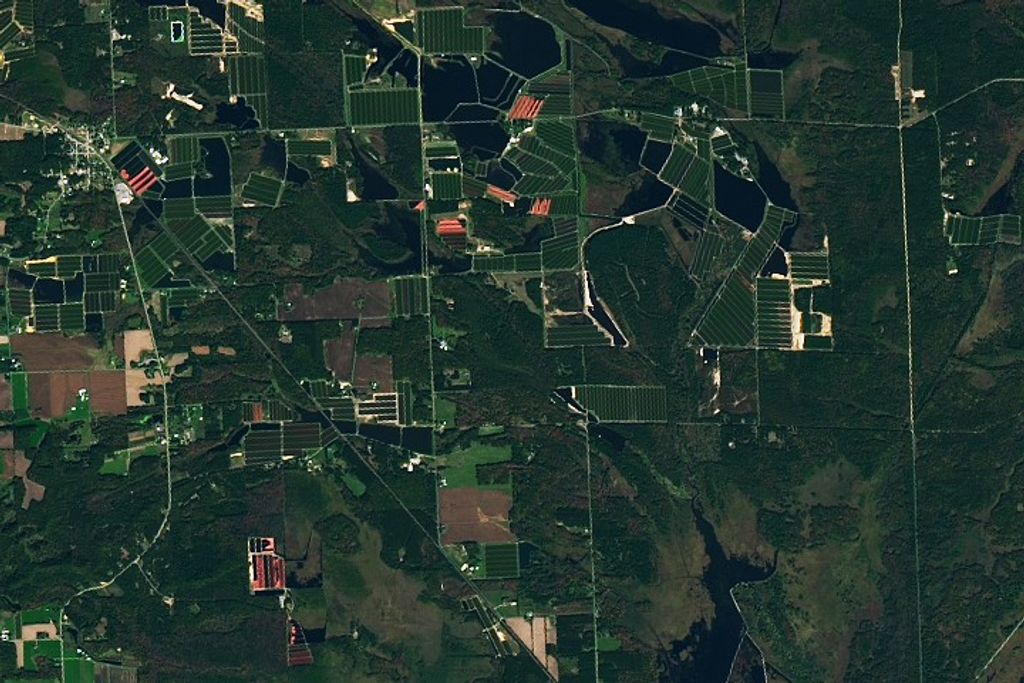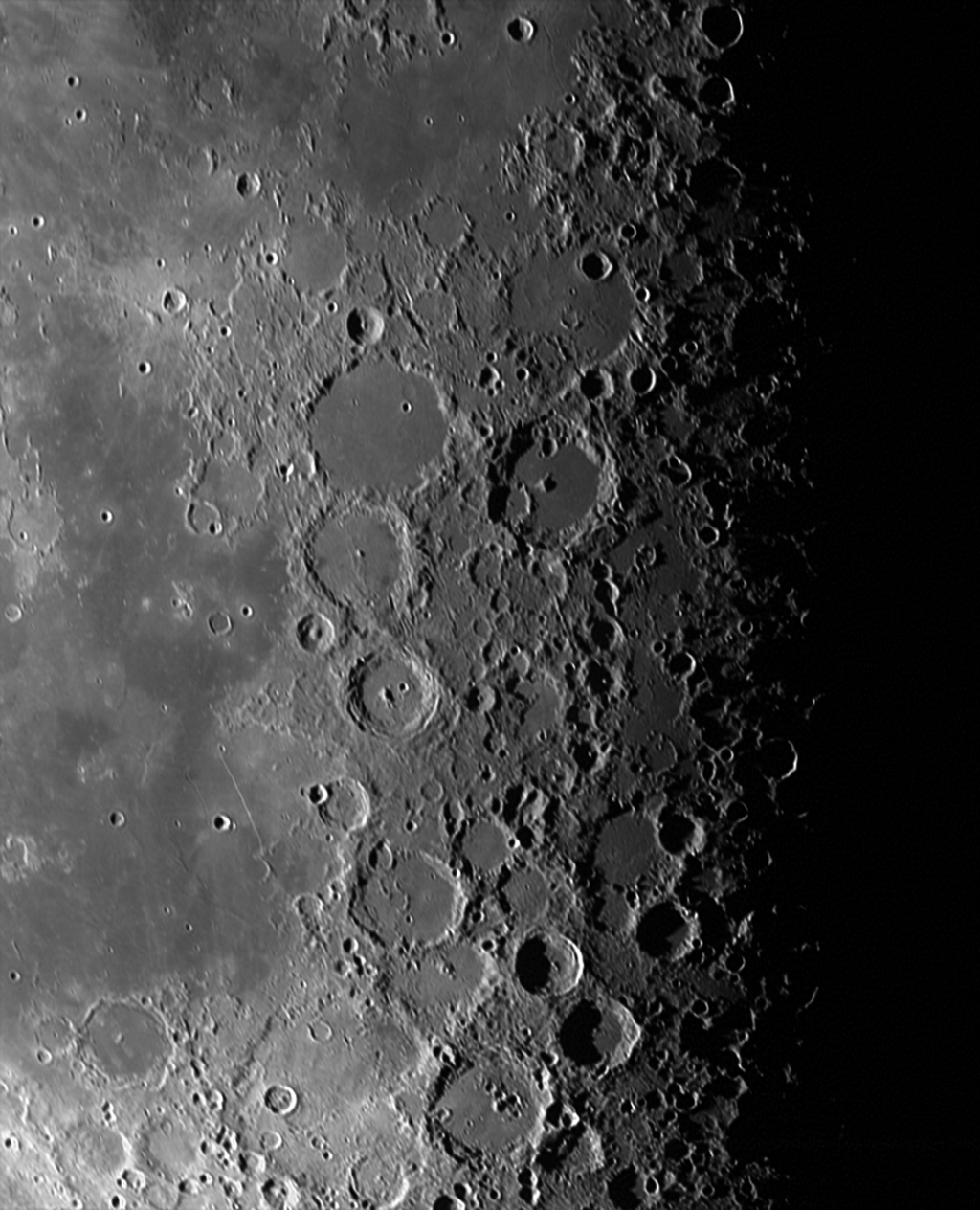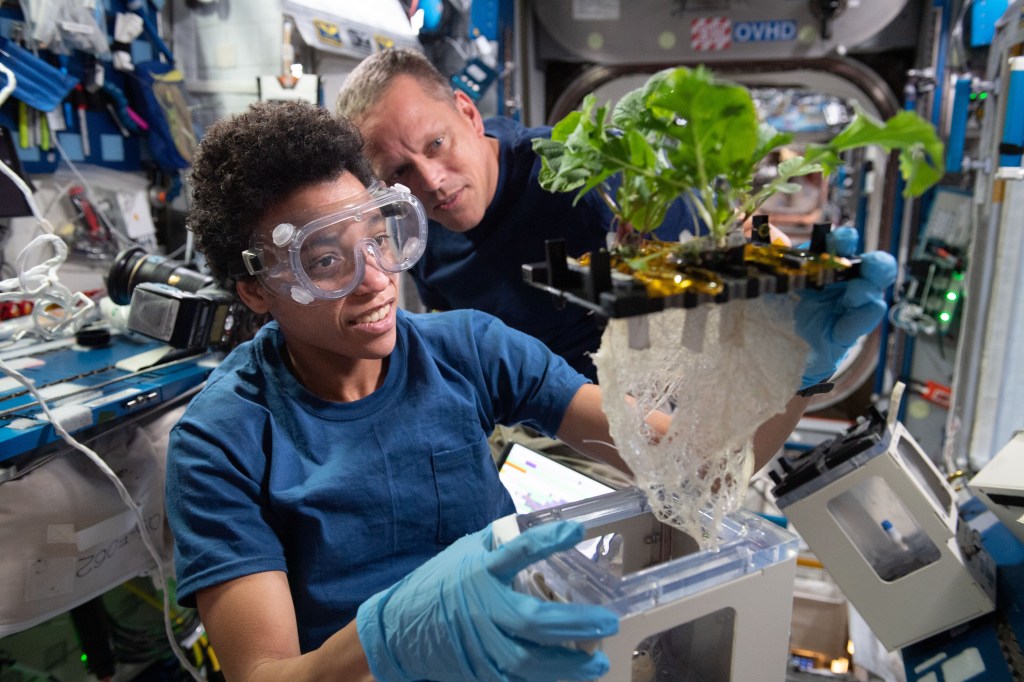1 min read
Violent Star Formation in Heart of Starburst Galaxy M82
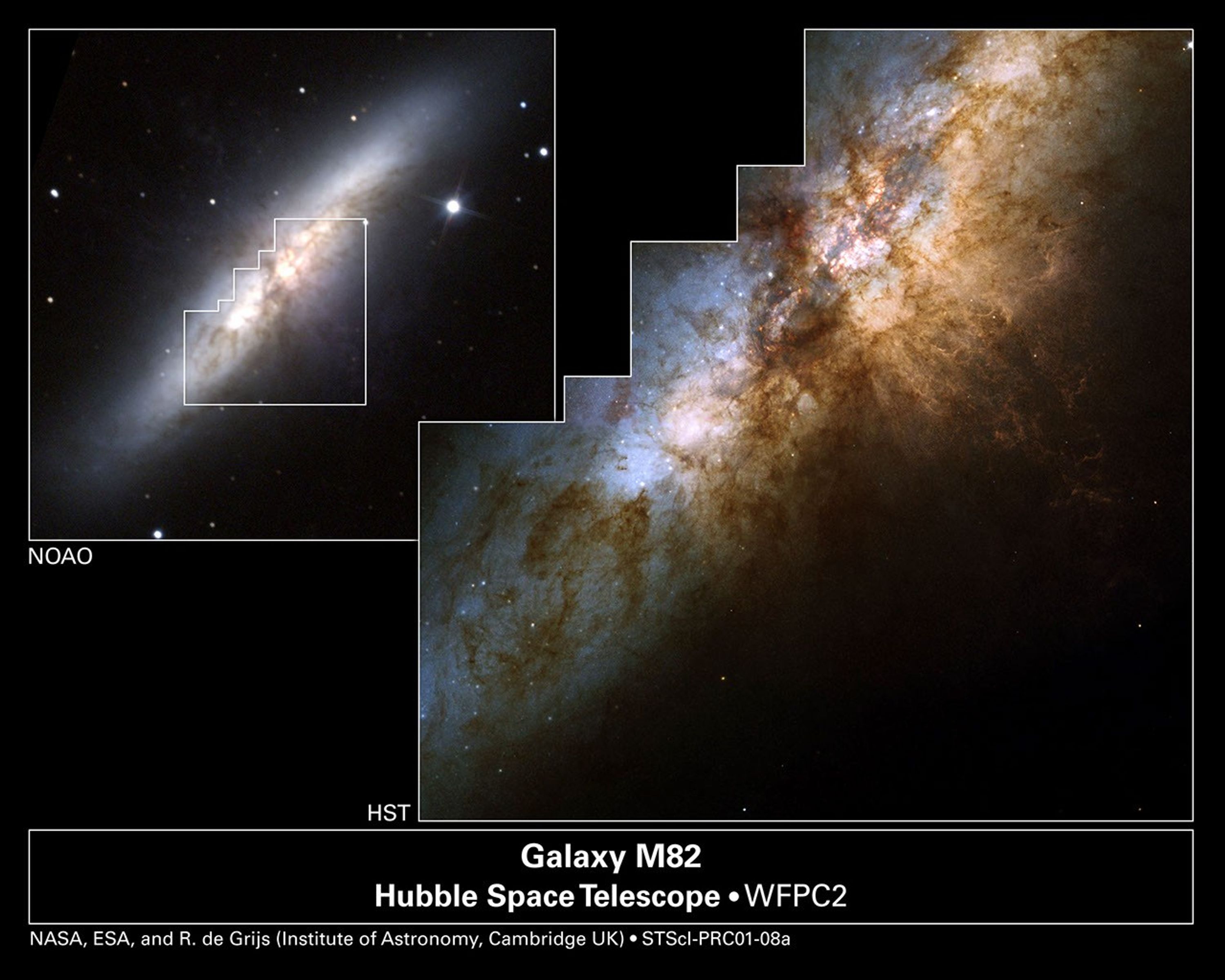
This stunningly beautiful image [right] taken with the NASA Hubble Space Telescope shows the heart of the prototypical starburst galaxy M82. The ongoing violent star formation due to an ancient encounter with its large galactic neighbor, M81, gives this galaxy its disturbed appearance.
The smaller picture at upper left shows the entire galaxy. The image was taken in December 1994 by the Kitt Peak National Observatory's 0.9-meter telescope. Hubble's view is represented by the white outline in the center.
In the Hubble image, taken by the Wide Field and Planetary Camera 2, the huge lanes of dust that crisscross M82's disk are another telltale sign of the flurry of star formation. Below the center and to the right, a strong galactic wind is spewing knotty filaments of hydrogen and nitrogen gas.
More than 100 super star clusters – very bright, compact groupings of about 100,000 stars – are seen in this detailed Hubble picture as white dots sprinkled throughout M82's central region. The dark region just above the center of the picture is a huge dust cloud. A collaboration of European and American scientists used these clusters to date the ancient interaction between M82 and M81. About 600 million years ago, a region called "M82 B" (the bright area just below and to the left of the central dust cloud) exploded with new stars. Scientists have discovered that this ancient starburst was triggered by the violent encounter with M81.
M82 is a bright (eighth magnitude), nearby (12 million light-years from Earth) galaxy in the constellation Ursa Major (the Great Bear).
The Hubble picture was taken Sept. 15, 1997. The natural-color composite was constructed from three Wide Field and Planetary Camera 2 exposures, which were combined in chromatic order: 4,250 seconds through a blue filter (428 nm); 2,800 seconds through a green filter (520 nm); and 2,200 seconds through a red (820 nm) filter.
About the Object
- R.A. PositionR.A. PositionRight ascension – analogous to longitude – is one component of an object's position.09h 55m 52.18s
- Dec. PositionDec. PositionDeclination – analogous to latitude – is one component of an object's position.69° 40' 48.79"
- ConstellationConstellationOne of 88 recognized regions of the celestial sphere in which the object appears.Ursa Major
- DistanceDistanceThe physical distance from Earth to the astronomical object. Distances within our solar system are usually measured in Astronomical Units (AU). Distances between stars are usually measured in light-years. Interstellar distances can also be measured in parsecs.About 3.6 Mpc (12 million light-years)
- DimensionsDimensionsThe physical size of the object or the apparent angle it subtends on the sky.The visible portion of the HST M82 image is ~210 arcseconds (3.7 kpc) along the diagonal.
About the Data
- Data DescriptionData DescriptionProposal: A description of the observations, their scientific justification, and the links to the data available in the science archive.
Science Team: The astronomers who planned the observations and analyzed the data. "PI" refers to the Principal Investigator.The release image of M82 was created from WFPC2 archived HST data from the following science Proposals: 7446 (WFPC2/NICMOS observations): R. O'Connell (Univ. Virginia). Principal Astronomers: R. de Grijs (Inst. of Astronomy, Cambridge, UK), R. O'Connell (Univ. Virginia), J. Gallagher (Univ. Wisc-Madison), D. Hunter (Lowell Obs.) 6826: P. Shopbell (Cal Tech). Principal Astronomers: P. Shopbell (Cal Tech), R. Dufour (Rice Univ.), J. Cohen (Cal Tech), J. Bland-Hawthorn (AAO) - InstrumentInstrumentThe science instrument used to produce the data.KPNO 4-m (left), HST>WFPC2 (right)
- Exposure DatesExposure DatesThe date(s) that the telescope made its observations and the total exposure time.December 1994 (KPNO), and September 15, 1997 (HST)
- FiltersFiltersThe camera filters that were used in the science observations.Hubble data (right) Prop 7446 (WFPC2): F814W (I), F555W (V), F439W (B) Prop 7446 (NICMOS): F110W, F160W Prop 6826 (WFPC2): F656N (Ha)
- Object NameObject NameA name or catalog number that astronomers use to identify an astronomical object.M82, NGC 3034
- Object DescriptionObject DescriptionThe type of astronomical object.Irregular Galaxy
- Release DateMarch 7, 2001
- Science ReleaseHubble Spies Huge Clusters of Stars Formed by Ancient Encounter
- CreditHubble image: NASA, ESA, R. de Grijs (Institute of Astronomy, Cambridge, UK); Ground-based image: N.A. Sharp (Association of Universities for Research in Astronomy, National Optical Astronomy Observatories, National Science Foundation)

Hubble image (right) Blue: 428 nm Green: 520 nm Red: 820 nm
Related Images & Videos
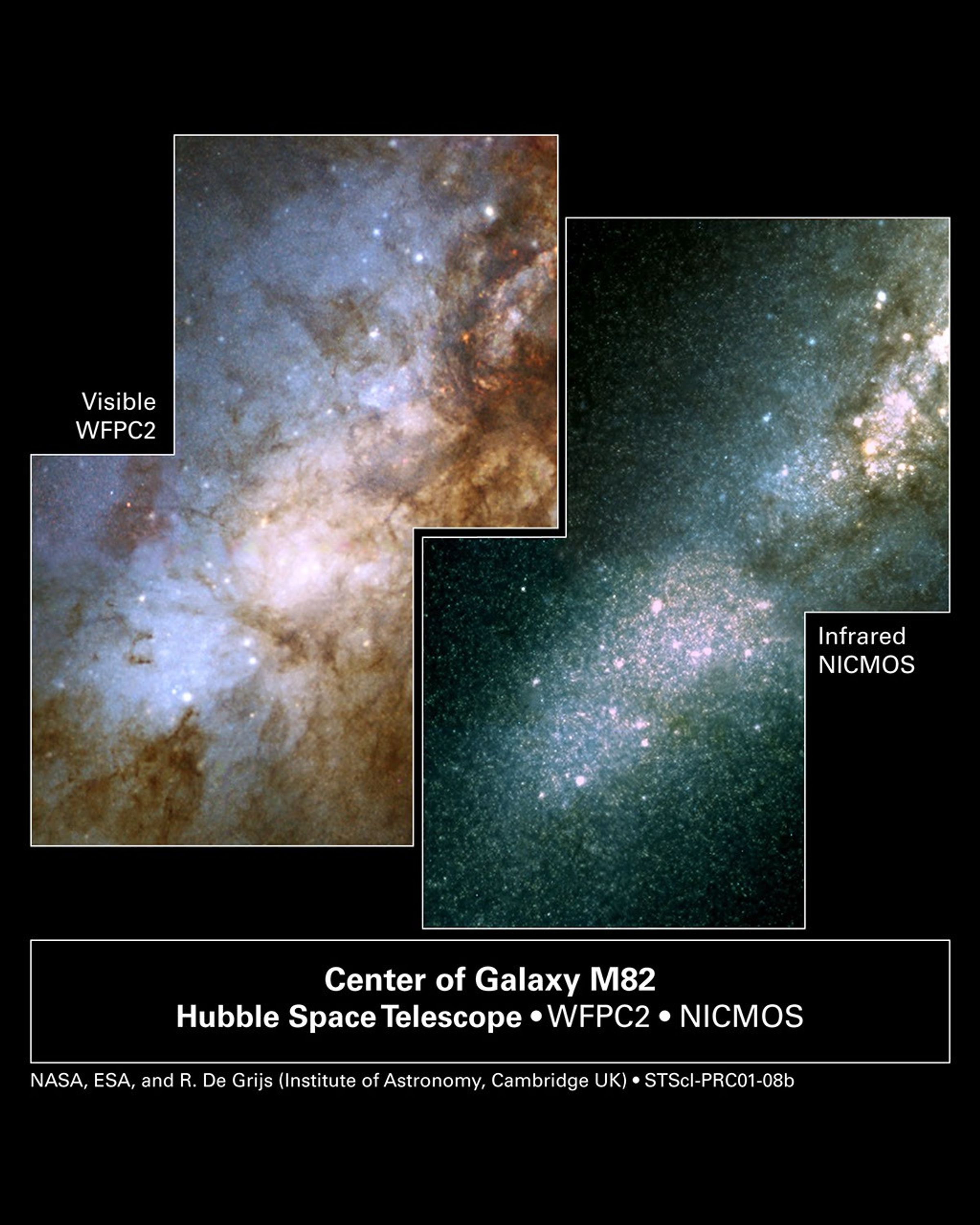
Hubble's Visible and Infrared Views of Nearby Galaxies Yield Clues to Early Universe
NASA's Hubble Space Telescope snapped these two views of the heart of the galaxy M82. The image at left was taken in visible light; the picture at right, in infrared light. In the infrared view, the telescope's Near Infrared Camera and Multi-Object Spectrometer peered through...
Share
Details
Claire Andreoli
NASA’s Goddard Space Flight Center
Greenbelt, Maryland
claire.andreoli@nasa.gov










